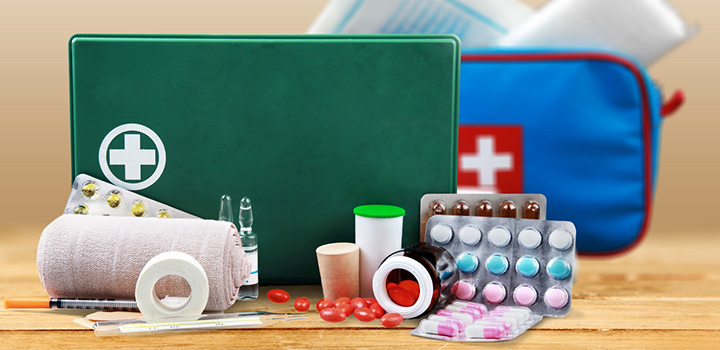Medicine cabinet clean-out? Factors to consider in a first aid kit

Have you come across a dusty first aid kit while spring-cleaning your medicine cabinet? Before you toss it back in, here are some handy guidelines on what it should include. After all, a kit is only as useful as what you can do with it!
Having a kit in your home is a wise and conscientious measure to take, but less so if you haven’t looked at its contents since you acquired it! When you really need a first-aid kit, what you don’t generally have it the time to hunt through a mess to find the equipment you need, and to clue yourself up on how to use it. Carefully planning what you include in a first aid kit will ensure it’s as helpful as possible if the time comes to use it.
There is no one-size-fits-all solution for first aid kits. This is why it’s important to assemble your own one after taking these four factors into account:
1. Who will have access to the first aid kit
When deciding what to include, consider the level of medical and first aid training you and the people around you have, or are willing and able to get. Having equipment which nobody within range knows how to use simple simply as waste of money and space. For instance, most first aid kits contain a triangular bandage, but if you haven’t had any first aid training, you would probably won’t know what to do with it.
Medicines in a first aid kit is a tricky situation. On the one hand, they can be useful in treating a number of problems. On the other hand, they have expiration dates (usually just a year or two from the date of manufacture) and can be affected by heat while it is in your kit. Other potential problems with medicines include allergic reactions, overdosing and interactions between different medicines. As such, a lot depends on whether those with access to the kit know when and when not to use what’s in it.
2. How far you are from your nearest doctor or pharmacy
Another factor that determines the size and contents of your first aid kit is where you stay. If you are in a big city where there is a pharmacy, doctor and casualty ward around the corner, you’re less likely to need a big, comprehensive first aid kit.
If you stay in the countryside where advanced medical care is less accessible (or at least, not as reliably or quickly available as in an urban area) you’ll need to include more supplies in your kit. Expand your first aid set into a more comprehensive medical kit so you can better help people until they can get to the nearest healthcare facility.
3. How big your family is and what kind of emergencies you expect
Consider the kind of accidents that are likely in your household, and the number of people who may need help at the same time.
Examples of situations for which you may need a kit include minor cuts, scrapes, allergic reactions and burns, splinters, non-life-threatening insect bites and stings, blisters, rashes, sprains and strains, something stuck in the eye, hypoglycaemia, aches and pain, and digestive system problems (nausea, indigestion/heartburn, diarrhoea or constipation).
If you stay on a farm or in the countryside, you may also have to prepare for situations like farming accidents, snake bites, broken bones and heat stroke.
4. Existing conditions and allergies of those who need help
You know your family’s health conditions, so consider how you can best cater for them. If you have visitors who get hurt or you’re looking after more people than just your immediate family (like others on a farm), find out if there are any chronic illnesses (like glaucoma, bleeding disorders, heart problems and kidney problems, for which many over-the-counter medicines is prohibited).
Then ask about allergies and any known adverse reactions to medicines. Learn how to handle an allergic reaction (i.e. to a food group or a bee string) and how you can avoid giving them something which can trigger an allergic reaction. Finally, ask about conditions like asthma, diabetes and epilepsy and how you can help them if they have an attack or incident.
These are useful factors to remember when a household accident occurs. We’ve also put together more specific lists on the kind of medicines and equipment you can use to stock up your home first aid kit. Read the article here to learn how to refresh and update your existing first aid kit, or assemble a new one from scratch!
Have emergency contact details close at hand
Remember to store details of emergency services and contacts in an easily-accessible place, like a note posted on the fridge door, as well numbers saved on the phones of everyone in your family.
If you are a Discovery Health Medical Scheme member and require medically-equipped transport, call 0860 999 911. This line is managed by highly-qualified emergency personnel who can send air or road emergency evacuation transport to your address if you need it.
Related articles
Having bipolar disorder doesn't define me
Discovery Health Medical Scheme member, Emma Attwell opens up about her journey with mental illness and shares the value of sound medical aid when faced with numerous health challenges.
The emotional impact of a cancer diagnosis
A cancer diagnosis can be traumatic, both as a patient and as a loved one. Here’s what to expect.
Learning from adversity: A Breast Cancer survivor's story
Norma Moller shares her experiences during her rollercoaster cancer treatment journey that has left her wiser, Learning more aware, more disciplined, and an expert when it comes to her own body.